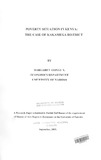| dc.description.abstract | This research paper assesses empirically the poverty situation in Kakamega District. The
third Welfare Monitoring Survey data was used. The survey was done by Central Bureau
of Statistics, Ministry of Finance and Planning.
The model developed by Foster, Greer and Thorbecke in 1984 was used in this study to
compute poverty measures. The model uses the FEI-based poverty lines that were
computed from the same data to construct poverty measures.
The results indicate that more than half the population of Kakamega District live in
poverty, especially in the rural areas. The results also show that rural poverty is too high
as compared to urban poverty. As it was found from the results, it is important to
disaggregate data to the lower levels like the district than always using national and
combined data because it gives more acurate estimates of poverty. There are also
measures suggested in the study that should be consi~a for poverty eradication in
Kakamega and other regions in Kenya in general. | en |

